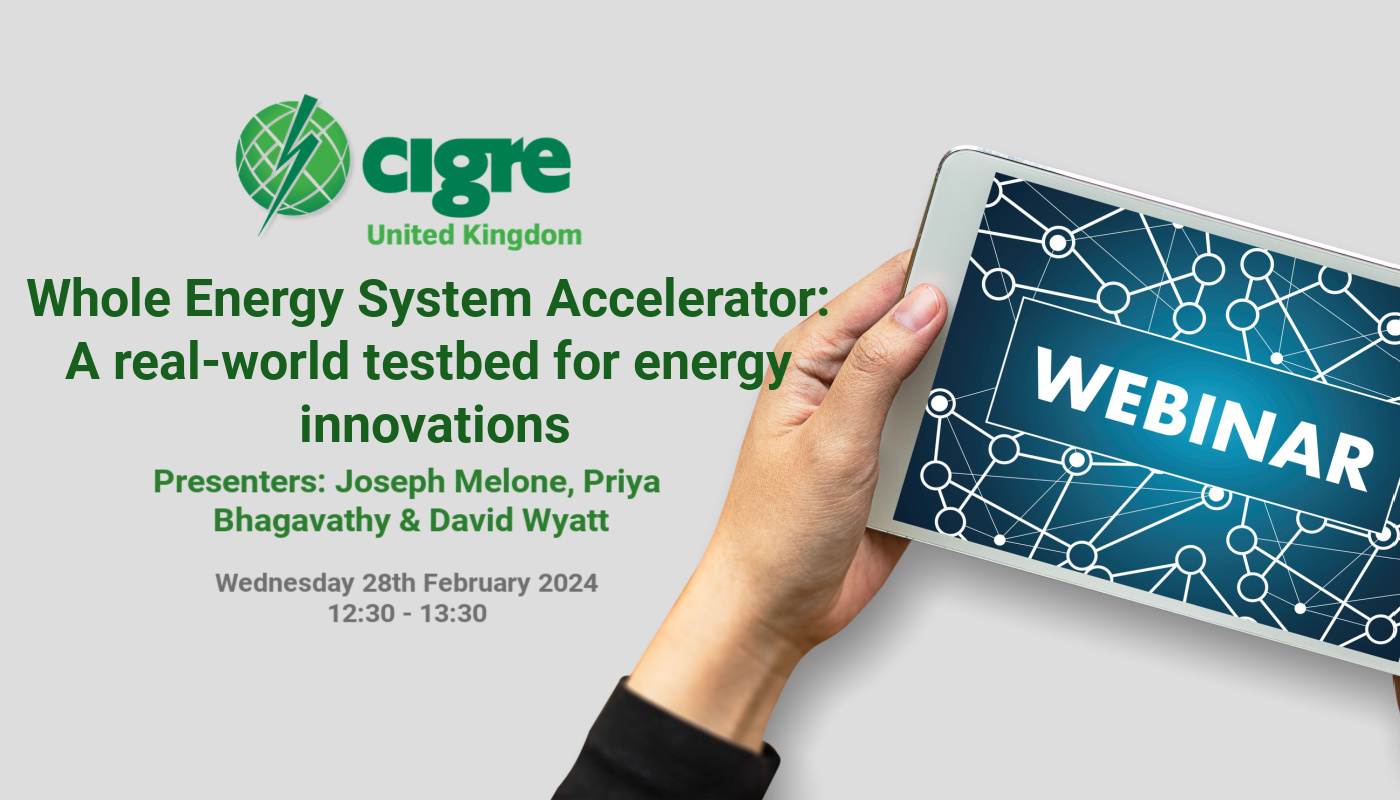
About this Technical Webinar:
In this webinar, Joseph, Priya and David presented a novel testing and demonstration platform for future power system scenarios, where real households can interact in real-time with network hardware in a closed feedback loop. This testing and demonstration platform, named the Whole Energy System Accelerator (WESA), is developed by PNDC and Energy Systems Catapult to enable tests in a whole system context of potential interventions at the domestic, network and/or wider system level.
At the distribution level, rapid decarbonisation of heating and transport and the growing penetration of distributed energy resources can result in new patterns of generation and demand. Consumers on a local network will collectively influence the network state, however, the prevailing market arrangements and consumer preferences will determine individual reactions to this state (which may include demand-side response).
The WESA testing and demonstration platform enables a holistic exploration of this two-way interaction between networks and consumers, with a focus on the domestic setting, to accelerate innovation in different areas of the power system, in a safe environment without direct impact on the real network. The platform is modular, flexible and reconfigurable to support different study types and different future scenarios, in particular LCT uptake rates and market structures, supported by algorithms to emulate actions of market participants in response to real-time network data and other inputs. The loop is closed by control signals and Time-of-Use tariffs that can be sent back to households to understand the consumer response. The platform also allows detailed technical monitoring of homes and LCTs, and consumer studies can be undertaken to elicit households’ experiences of new energy propositions.
They outlined the technical details of the WESA Feedback loop, illustrate the possibilities it enables, and highlighted how the results could contribute insights to stakeholders across the power sector.
To view the presentation please click here: WESA CIGRE 2024 presentation slides
Video Recording
Presenters: Joseph Melone, Prima Bhagavathy & David Wyatt

Dr. Joseph Melone
Joe is part of the Whole Energy Systems team at PNDC, currently focusing on developing model power distribution networks and systems using PNDC’s real-time digital simulator system, and delivering unique testing capability for the diverse technical solutions which will be integrated into the low carbon energy system of the future.

Dr. Priya Bhagavathy
Priya is an Oxford Martin Fellow and a Chartered Engineer with 15+ years of experience in energy systems. She is a Lead R&D Engineer in Whole Energy System at PNDC where she develops and delivers a portfolio of technical research and innovation projects in Whole Energy System and Hydrogen. She is also leading the design and delivery of a whole system innovation facility which has up to 1 MW electrical capability with 750kW thermal capability and a hydrogen network. Her research focuses on the integration of heat and transport into the electricity vector and the role of hydrogen in the transition to net zero. She has one patent filed and two patents pending in the area of hydrogen.

Dr David Wyatt
David leads the Dynamic Energy Systems Simulation activity at Energy Systems Catapult. His team develops and applies novel whole-system simulation models of future energy scenarios, to provide evidence to inform decisions about the deployment of new technologies and new market structures, with a particular interest in energy flexibility. Their focus is on fine-grained representation of physical, commercial and digital systems, both in silico and as real-time simulations linked to real-world components. David has experience across innovation, research and design engineering, having worked as Associate Principal Engineer at a UK technology company after a University of Cambridge PhD in Engineering Design Research. He is a Chartered Engineer and has three granted patents in the field of consumer robotics.

Q&A
Questions answered on the call:
How does the loop between PNDC-Homes in the living labs being secured from potential adverse cyber interferences?
Ans: Security and privacy are something we take very seriously in WESA, in both the Catapult and PNDC systems, recognising that we are working with data from – and control over – real households’ homes. We use different security mechanisms at different points in the architecture, depending on technical considerations, but these include OAuth 2 to allow households to securely authorise Living Lab’s access to their devices, and IP whitelisting to restrict access to nominated machines within the WESA system with SSL encrypted connections for data transfer. We regularly audit our security.
Can WESA be categorised as a Digital Twin of consumers and Energy systems?
Ans: In the strictest sense of the term, a WESA scenario is not a Digital Twin since there is no pre-existing real system of which it is a representation, and the representation is not fully digital since we specifically include real households and/or real network hardware. More generally, WESA has a place in the broader Digital Twin landscape since we are using digital technologies to understand how alternative scenarios might unfold on a physical system.
What is the resolution of energy data collected from the homes? Is it half-hourly, based on their general meters?
Ans: WESA actually uses 1-minute resolution electricity usage data, collected in close to real-time, using Consumer Access Devices (CADs) that receive data from homes’ smart electricity meters over the Home Area Network (HAN) created by the smart metering system. We also collect gas meter data in real time, but this is restricted to half-hourly resolution by the metering system. However, this requires the household to accept a physical CAD unit in their home and connect it to both their HAN and their home Wi-Fi network.
The Living Lab can also collect smart meter data via the existing smart metering infrastructure (the DCC and a third party service provider), which purely requires the household to authorising our access to their data with no further action needed, but this is restricted to half-hourly data for both electricity and gas and is only available 24hrs in arrears so is not applicable to real-time WESA studies.
The Living Lab also has the capability to communicate with additional metering and sensing devices, e.g. circuit-level electricity monitoring, heat output monitoring from heating systems, and indoor environmental sensing. However, this is obviously more invasive and so we would have to recruit participants specifically to have these sensors installed (normally in the context of a particular project).
What facilities are available to study in PNDC at each voltage levels?
Ans: In physical terms, PNDC have an 11 kV connection to the Scottish Power distribution network, and a containerised substation which protects the test network. The test network is decoupled from the supply using a motor-generator set with a variable-speed drive. This set-up allows the study of frequency changes, and an on-load tap changer on our 11kV-11kV isolation transformer allows the 11 kV voltage to be shifted by +/-10%. We have sections of overhead and underground cabling, so can test 11 kV sensors and fault detection/protection equipment. PNDC has 4 ground-mounted 11/0.4kV distribution transformers rated in the range of 100-500 kVA, alongside a selection of smaller pole-mounted transformers, including 3-phase 50 kVA units and single-phase 25 kVA units. The distribution transformers connect to a series of indoor test bays via external feeder pillars, giving multiple options for studying the power flow and network impacts of single-phase and three-phase loads and generation. The test compound includes resistance and impedance units which emulate up to 60 km of 11 kV cabling, and PNDC have a fully programmable power electronics converter system which can generate a wide range of transient or harmonic waveforms and can also be used to interface DC power systems to the PNDC network at voltage levels up to 3 kV.
From a simulation perspective, the RTDS was originally built to simulate transmission networks so asset behaviour is well-covered at up to 400 kV. Power flow calculations and faults are similar, and many of the pre-built model components like transformers and generators have settings for transmission level voltages.
What is the availability of Living Lab data to UK 3rd parties?
Ans: Energy Systems Catapult has published a selection of data collected from the Living Lab on our data platform hosted by Usmart – link here. We are also happy to enter into collaborative projects with other organisations where we can share different or more targeted subsets of data. We are in the process of developing an affordable data service for researchers and commercial innovators, which should be available later this year to make data more widely available outside of trials and other projects.
Is WESA open to short collaborative research work, e.g. testing models?
Ans: Yes, absolutely – we have developed WESA as an open and flexible facility that can support a wide range of organisations in the sector. If you would like to discuss collaborative projects, please get in touch via wesa@es.catapult.org.uk (Energy Systems Catapult) and/or pndc@strath.ac.uk (PNDC).
The so-called “Pesky” Human behaviour will expect to introduce n-number of consumer behaviour scenarios. Are you considering any predictive analysis to include these behaviours in WESA?
Ans: The primary aim of WESA is to make it possible to include real human behaviour in studies, by linking Living Lab homes into modelled scenarios in real time – since this will give a better reflection of how a scenario might play out than a model. However, for practical reasons we are currently looking at appropriate ways to augment real homes with simulated consumer demand, to allow generation of broader insights but still anchored in real consumer responses. To do so we will draw on the existing knowledge we have through previous Living Lab studies, as well as results of other studies and trials in the wider sector.
Why do you need RTDS system which is meant for 50 Micro seconds simulations to analyse the consumer behaviour or energy market operation which will be in minutes to hourly to daily time scale?
Ans: You’re absolutely right that the speed of the RTDS is not required to represent slower dynamics of consumer response and/or market operation. However, the benefit of using RTDS network simulation is the ability to incorporate real network assets into WESA studies (via Power Hardware in the Loop), taking full advantage of PNDC’s test facilities.
Does the simulation include home cost optimisers (managing in-home PV, battery, HP), which (historically) clash with top-level concerns?
Ans: If appropriate for a scenario, we can choose to include homes with optimisers in the cohort for a study. More generally, one of the areas we are keen to explore further with our market emulation capability is how to align market incentives between different stakeholders such that the behaviour that is incentivised at the home level (i.e. the behaviour that is exhibited by optimisers) is more in line with top-level concerns.
What is the most surprising and unexpected thing that you have learned from the Living Lab?
Energy Systems Catapult has undertaken many research projects using the Living Lab since we created it over the last five years – including assessing the consumer response to the energy crisis, identifying the presence of low carbon technologies from smart meter readings, and analysing the behaviour of our participants during Demand Flexibility Service events. However, some of the most interesting findings from my (David Wyatt)’s personal perspective were the results of analysing the different ways that domestic consumers use heating – with quite dramatic differences between segments. See report here and a summary graphic.
Questions we sadly ran out of time for:
How does the RTDS study long time-frames e.g. over years? Other tool for that?
Ans: If it suits the scenario, the data input can be sped up so that for example a load profile could be modelled faster than real-time, assuming the data is not live. PNDC don’t currently envisage using Power-Hardware-in-Loop for long term testing but if it is possible to characterise network impact and/or system response using short-term PHiL testing, then longer term RTDS-only testing could be viable for long time-frames. Alternatively, PNDC have used SIMULINK, PSCAD or other solutions for load-flow studies.
I am interested in the demand profile seen by the 11/0.4 kV txformer. I suspect the new LCT loads will impact asset life. Can 3rd parties access any long-term measurement data?
Ans: We do indeed expect to see an impact on asset life due to new LCT loads on distribution networks. At the moment WESA is likely to be used for short-term trials, but we would be open to running longer-term trials or looking in more detail at the expected impact that observed load profiles from WESA feedback loop operation are likely to have, since this would be unique data.
Any Harmonics measurements / studies from all these inverters/converters?
Ans: At present the WESA data pipeline is based on measurements of real power import/export by homes at 1-minute resolution, and does not cover harmonics or other effects (e.g. non-unity power factors). The RTDS is capable of representing harmonics and reactive power, and so can include such effects where they do not come from in-home measurements (e.g. other sources on the simulated network and/or Power Hardware in the Loop). We are exploring how the WESA data collection architecture could be expanded to represent these impacts of in-home low-carbon technologies on the power system.
DSO dispatches EV charging? But I use timers to get min £cost overnight – don’t want DSO involvement
Ans: We are of course conscious of the need to protect the interests of our participants during trials – see next answer for more details.
The narrative behind the example scenario that prompted this comment is that the DSO would have offered to purchase flexibility from households, and that the households would have agreed to sell flexibility, at a price acceptable to both, through a mechanism analogous to the ENA Active Power Service flexibility contracts. For situations where a household is on a time-of-use electricity tariff, this would imply that the DSO’s offer price would have to outweigh the potential difference in the household’s cost for charging their vehicle at off-peak times vs peak times. (Of course, the DSO’s offer price might not be in p/kWh terms but might be expressed in £/utilisation, or some other format.)
There are many ways in which this scenario might be embodied in terms of a proposition facing the households – some of which might not involve a direct relationship between the DSO and the household, but might go via a supplier/aggregator (who would pass through the dispatch signal in a “rebadged” form). There are already precedents for distribution system operators procuring flexibility from households via different routes, including National Grid Electricity Distribution’s project Sustain-H and UK Power Networks’ Project Shift – the second of which involved a DNO procuring flexibility from smart EV charging via a direct pass-through signal into a smart charging platform. It is true that any proposition based on direct dispatch would be more complex from the household’s perspective than a standard time-of-use tariff (i.e. with fixed “off peak” hours determined months in advance, which a household might set timers to make use of), but there are already EV-oriented propositions coming onto the market of this form (Octopus’ Intelligent Octopus Go, OVO’s Charge Anytime, British Gas/Hive’s FreeCharge).
Where do market bills/costs/monies go? Not on consumer I hope!
Ans: As discussed in relation to the previous question, the narrative for a scenario we might investigate using WESA would have to include a proposition by which the consumer might be rewarded (in net terms) for flexing their demand – otherwise uptake of flexibility would be expected to be limited.
In practical terms, we are of course conscious of the need to protect all aspects of our participants’ wellbeing during trials. This would include making sure that participants in a trial involving in-home flexibility would not suffer any risks from taking part. From a financial perspective specifically, participants in the Living Lab are not obliged to change their energy supplier to take part in studies and so they would still be exposed to their existing energy tariff – even if the interventions resulting from a WESA study would increase their costs (e.g. by causing their EV to charge during peak times). As a result, we think carefully about how to use incentive payments as part of a trial to cover any additional costs participants might incur on their energy bills, as well as other requirements of a trial e.g. requests for participants’ time to undertake activities, or upheaval costs from trialling physical in-home equipment. If appropriate, we can structure the incentive payment to incentivise participants to behave as if the scenario tariff were their real tariff – e.g. starting with an incentive balance that is eroded based on the costs their usage would incur in the scenario.
My EngD studies 2014-2020 of EVs found many overload scenarios. Focus was on EV modelling (4.9 billion individual trips tracked) and charging impacts. Various summaries on my RG pages: Steve Broderick https://tinyurl.com/2a4heka7
Ans: Thank you very much for this pointer. We think there is definitely a role for pure-computational simulations as well as WESA studies, due to the practical limitations in scale of any trial involving real participants in real time (which your statistic highlights!).
Could you please clarify from where exactly are meteorological/weather data (ambient temperature, solar irradiance, wind speed, etc.) collected or obtained for the analysis and what resolutions are available?
Ans: The Living Lab homes are real homes, and will be subject to the weather conditions prevailing at their location. Likewise, physical hardware at PNDC will be subject to real weather conditions at its location. Where weather data and/or forecasts are used as inputs into the computational elements of a WESA scenario, we obtain these from a number of different third-party sources. We have published a number of weather datasets for Living Lab homes that align with other datasets we have published.
apologise – have another meeting at 13.30 – excellent presentation giving an overview of PNDC – such important work in the fast moving electricity management and technology area, with the push for net zero and energy security – thanks to all involved
Ans: Thanks Mike, at PNDC and Energy Systems Catapult we agree there’s so much to do in this fast-moving sector. These challenges actually offer a lot of opportunity for studying safe deployment for automation, consumer interaction, cyber-security, not to mention how crucial energy is for our everyday lives.
How does one become a Living Lab volunteer?
Ans: It doesn’t matter who you are, what kind of home you live in, whether you’re into the latest technology or need a bit of reassurance with it. Whatever your circumstances, you can sign up on our recruitment site here.
FYI there is much car travel info out there allowing modelling of EV trips hence consumption. Easy to model (simulate synthetic data) trips at good fidelity, hence charging consumption.
Ans: Thank you for the pointer – indeed, previous studies have provided rich data on EV usage patterns (including the Consumers, Vehicles and Energy Integration study for which Energy Systems Catapult now hosts a collection of the resulting data). One of our aims with WESA is to represent not only the aggregate consumption of EV usage but also the realities of human behaviour, both in response to interventions such as different flexibility proposition structures and rewards for behaviour change, but also the genuine diversity of ways in which real people use the new technology that is starting to be deployed in the energy system.
